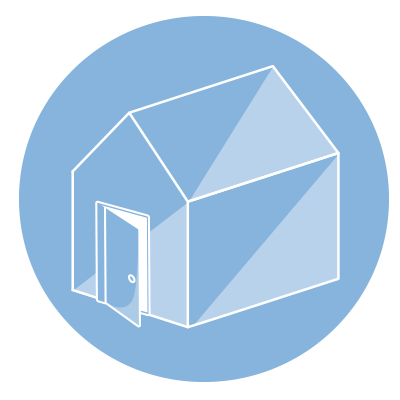Unfinished
The first step
Construction of a building in the unfinished state includes:
- Connections to the foundations
- Walls
- Floors
- Stairs
- Roof structure
The Sistem timber house is constructed on the basis of a load-bearing frame in premium quality, selected, dried and planed spruce wood.
The load-bearing structure is constructed with closely spaced vertical studs and horizontal joists that together form the timber frame. The frame is subsequently clad on both sides with wood panels (OSB type) fixed by means of nails. The insulating material is inserted between the studs and a vapour barrier membrane is affixed to the interior side.
This system means that the structure is intrinsically antiseismic at all levels without any additional cost (unlike in the case of conventional buildings).
Walls
Load-bearing with laminated structure
For the XLam system the walls are formed either using a single element having all door and window openings, or through the assembly of multiple panels interconnected by means of mechanical connections formed of strips of multi-layer panel or with tongue and groove joints between panels and with screws or nails. The openings are created between the panels making up the wall, and the architrave (or parapet for windows) is formed with panel elements arranged with the primary frame of the boards in the horizontal direction and housed and coupled in locations machined in the lateral panels. In the case of walls formed of a single panel, the door and window openings are made by pre-cutting the panel directly in the works. One piece walls or walls assembled on site are completed on the joints on the interior side by applying butyl tape to create an airtight seal.
Load-bearing with frame structure
Our Platform-Frame building is composed of walls consisting of a timber frame, generally made of solid wood but also of laminated wood depending on structural requirements, comprising studs positioned at a centre-distance of 40-60 cm, an upper beam and a lower beam.
Both sides of the frame are finished by applying OSB structural cladding that completely covers the frame, connected to the studs and joists by means of ring-shank nails, and to the floor structures and foundations by means of metal angle brackets.
The thus assembled frame is completed by inserting thermal and/or acoustic insulating material in the spaces between the studs and applying a vapour barrier membrane on the interior side and a breathable membrane on the exterior side, while the joints on the interior side are completed with butyl tape to guarantee that the wall offers an airtight seal.
The Floor
Once the ground floor walls have been erected the panels of the intermediate floor are laid and connected to the walls below and one to the other with screws and metal fittings.
Intermediate floor with Xlam structure
For production and transport requirements Xlam panels for intermediate floors are between 125 and 280 cm in width and are interconnected by means of closely spaced screws and nails in such a way as to create a rigid connection in compliance with capacity design requirements. The connection to the underlying walls is made once again with screws, which are inserted at an angle with respect to the vertical plane of the wall in such a way as to intercept multiple layers and are closely spaced in order to create a sufficiently rigid joint.
Intermediate floor with frame structure
The frame structure floor is made of solid or laminated wood beams, preferably arranged on top of the wall studs and by
engineered timber structural cladding panels (plywood or OSB) similar to the panels employed for the walls, connected to the floor joists with nails around the outer edges of the panels and on the internal supports. The structure of the floor is then completed with a plinth positioned around the entire perimeter. The thus assembled frame is finished by inserting acoustic insulating material and a vapour barrier membrane in the spaces between the studs. Joints on the underside are completed by applying butyl tape to provide a perfectly airtight seal.
Intermediate floor with exposed joists type load-bearing structure
The intermediate floor can be built on site with laminated wood technology, connecting joists in laminated wood to the walls at a centre distance of approximately 50 cm and having an adequate cross-section. A rigid deck is then nailed to the exposed joists; said deck having a selectable finish and being protected by a breathable membrane, with metal fasteners located at a constant centre distance and completed with a reinforced concrete screed of 5/6 cm in thickness, incorporating an arc-welded metal mesh.
Stairs
The stairs can feature a timber load-bearing structure with false treads (central stringer stairs) or they can have side stringers, shaped with the profile of the steps, with risers and treads in laminated wood (two-stringer stairs).
Wooden Roof
With exposed rafters
Once the walls of the top floor have been erected it’s time to build the roof frame. This is usually constructed with a traditional structure with ridge beam and rafters or by means of light roof trusses connected to the top plate for connection of the walls, on top of which is positioned and connected a rigid deck structure and possible crossed stiffening planking or an OSB structural panel. Thereafter, the planking is equipped with vapour barrier membrane applied with overlapping and taped joints.
Xlam
Construction of Xlam roof structures essentially follows the same application options discussed for the intermediate floor, with the only difference that in this case the roof structure can be created with the insertion of exposed or concealed load-bearing rafters, joists, and structural elements that can also add aesthetic appeal to the interior space. Also in this case the Xlam panel is equipped with a vapour barrier membrane with overlapping and taped joints.
Sistem Costruzioni proposes Casa Natura system packages for timber roofs for houses and buildings. Each construction system offered is a technical solution designed to comply with thermal, acoustic and health requirements. Widely diverse weather conditions in various parts of the world and differing building use specifications preclude the adoption of a single universal system. That’s why our solutions can be implemented and optimized in relation to the specific needs of the customer and the construction environment.
Do you want more?
Here are other ideas and solutions
Are you interesed?
Let us suggest you!
The purchase of your own home is a moment full of expectations and needs.
Precisely for this Sistem Costruzioni is the right choice: a solid, earthquake-proof, comfortable, eco-friendly, fire-resistant, energy-efficient and above all beautiful !!
Get in touch with our technicians who will explain you how to make the house of your dreams .


 Home Page
Home Page


